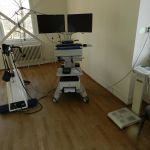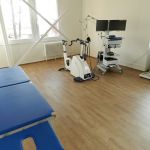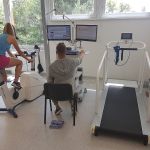Laboratory of Functional and Load Diagnostics
Body Composition Analysis
Description: We perform body composition analysis using the bioimpedance method (InBody). This involves determining the percentage of body fat, body water,
as well as diagnosing the segmental distribution of muscle mass in the upper and lower extremities and torso as one of the auxiliary indicators of body load symmetry.
Spiroergometric test on a Bicycle Ergometer
Description: A maximal load test on a bicycle ergometer to determine VO2max and other workload indicators, determination of anaerobic threshold,
followed by training recommendations in the form of training zone protocols.
Spiroergometric test on a Treadmill
Description: A maximal load test on a treadmill, determining VO2max, ventilatory equivalent of oxygen (VE/VO2), ventilatory equivalent of carbon dioxide (VE/VCO2), and other
workload indicators, followed by training recommendations in the form of training zone protocols.
Wingate Test
Description: This test is used to determine anaerobic capacity and speed-strength abilities of the lower limbs. It is performed on a bicycle ergometer. The
result includes the determination of maximal anaerobic power, anaerobic capacity, and fatigue index.
Vertical Jump Test
Description: This test is used to determine jumping abilities. It is performed on a vertical jump platform.
Testing Package – Bicycle
(Body Composition Analysis, Spiroergometric test on a Bicycle, Wingate Test)
Field Lactate Test
Description: This test is used to establish the lactate curve. It is conducted on the track, running 4×2000 m (4×1600 m). The
result includes the determination of individual thresholds.
Laboratory Lactate Test – Treadmill
Description: This test is used to establish the lactate curve. It is conducted on a treadmill, running 4×2000 m (4×1600 m). The result includes the determination of
individual thresholds, spirometric, and spiroergometric parameters.
Laboratory Lactate Test – Bicycle
Description: This test is used to establish the lactate curve. It is conducted on a bicycle ergometer, for example, 4–5×4 minutes (individually adjustable). The
result includes the determination of individual thresholds, spirometric, and spiroergometric parameters.




